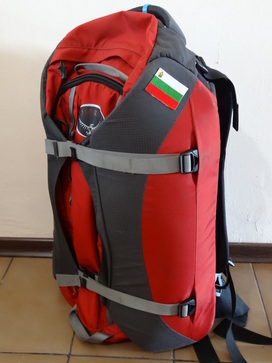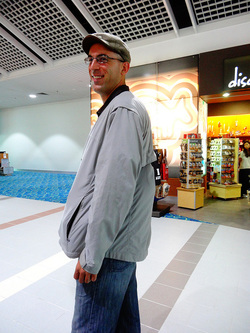 Neda's Porter still looks good after 2 years!
Neda's Porter still looks good after 2 years! The first step is getting the perfect luggage for a traveling vagabond. For us the research distilled down to the Osprey Porter, an amazing travel pack for several reasons. Firstly, it is the exact dimensions for carry-on luggage around the world. To help with making sure the pack fits into the little metal measuring cage the airline check-in staff sometimes make you put it in, the Porter is equipped with two compression straps. The straps have two settings for either mild compression or for full compression. We found that when “fully compressed” we could not only fit the bags into any plane, but often just threw them overhead onto buses as well. This was particularly nice in places like India where we had our packs inside the bus while other travelers had to tie their packs onto the roof!
 Our Pack Set-Up
Our Pack Set-Up A good packing system perfectly complements the layout of the Porter and will have you breezing through airports. We used one folder and one half cube of the Eagle Creek “Pack-It” system. The folders vary in size (we used the 15” inch size for Neda, who is a fairly small girl, and the 18” size for Jeff who is 6’2”), and neatly fit jeans, shirts, sweaters, and the like.
The cube fits all the small stuff like underwear and socks. On top of the cube there was room to put a small zipping bag (my mom had gotten it from a make-up promotion) where we kept computer charger, phone charger, and other small electronic stuff. Next to the half-cube we put a deluxe size REI toiletry bag. While it looks like that isn’t available on their website any longer, this one http://www.rei.com/product/834727/rei-grande-shower-kit, seems similar.
Once you’ve got all that in your pack, there is still room to put a pair of sandals and a pair of Vibram Five Fingers, which were a perfect travel sized athletic shoe. We could run, snorkel, and hike in the five fingers all while carrying around only 14oz of weight for Jeff and 7.5oz for Neda! Finally, on top of the shoes we squeezed our Osprey Daylight Daypack, which we used for our day hikes and trips around the cities. The pack is supposed to be able to “add-on” to the back of other larger Osprey packs, but we found that for the porter we could just stuff it in on top of everything else and it would work just fine. We only used one daypack as Neda usually carried a pursue with more secure things inside.
 eVest packed to the brim
eVest packed to the brim on our way to Tokyo.
We’ve talked above about the size of your luggage, but these days it’s not just the dimensions that have to work to be able to carry-on, it’s the weight as well. Most airlines allowed us 10kg, though on discount carriers that did not include a “personal item.” So the old trick of stuffing the purse wouldn't work. All 10kg have to be in one bag. Some of the worst airlines only allowed 7kg per person! We usually would wear our heaviest clothes like jeans and walking shoes on travel days no matter how hot it was outside. But our secret weapon in making weight was the Scott Evest. The jacket is designed with 20 sturdy pockets that can fit all kinds of things inside. On one side, there is a big pocket where I would put our netbook; on the other side, the bag filled with chargers.
 Can you see the sandals in the
Can you see the sandals in the pocket on the back?
 All of our clothes and toiletries
All of our clothes and toiletries O.k., so you’ve got all your fancy gear and you’re packed up and ready to go. Only with the extra souvenirs you bought, you realize that your pack is 12 kilos even with the E-vest loaded to the brim! What to do? It’s happened to us a few times and here were our strategies for getting through the airport:
* Wear layers – I would wear a shirt, the fleece, and the evest to keep the pack’s profile down. Not the most comfortable, but sometimes necessary
* Do a “counter drop” – when Neda & I would walk up to the counter to check in, she would let her purse drop to the floor and I would be carrying the daypack (with the extra weight in it) in my hand and also drop it. Usually the staff don’t see the bag since it’s not in their line of sight. Then, when they ask us to put the bags on the scale to be weighed we can make weight. 90% of the time the only weight check is at that counter, so if you can do a successful counter drop even when you know you are over weight, you’ll have a good chance of getting through. It's a bit sneaky, but so is charging us 30 euros for an extra two kilos!
* Wear the packs on your back – you’ll probably do this anyway, but we found that when most airline staff glanced at the packs they never even asked us to weigh them – they look more like school backpacks than luggage!
* Be ready for other checkpoints – a few times I took my fleece and jacket off and carried the computer in my hand since it can get hot to wear all that stuff. Once, right before security, they did another weight check. Luckily the computer was hidden under the fleece so it looked like I was only holding my jacket (which they don't make you weight) because I only passed that check by .3 kilos!
So there you have it folks – the gear and the strategy for saying goodbye to airline baggage fees forever. If you hadn’t noticed, it does require a certain commitment to the ultra-lite traveling lifestyle. Simply bring less stuff when you travel and make everything you have count. The longer we traveled, the more grateful we were for that decision and with each leg we found we brought less and less. It’s liberating to be able to fit everything into such a small space and gives you so much flexibility when riding buses, taking taxis, and walking around town. Though we used this gear for world travel, we are committed to using it whenever we travel from here on out. So get to it and have a great time! Happy trails!



 RSS Feed
RSS Feed
